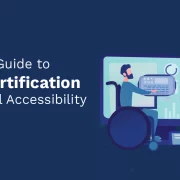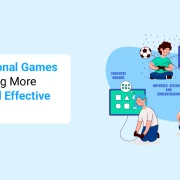
Key Elements in Workplace Course Development
Summary
Learn about the key elements of workplace course development, including needs assessment, instructional design, content creation, and evaluation to ensure effective training programs.
According to a survey, 76% of employees feel an inclination to stay with a company that provides them with continuous training opportunities. Moreover, 38% of employees recommend that companies tailor training programs to their job responsibilities.
Based on these stats, it’s clear that taking care of your employees’ upskilling needs is paramount, especially if you want to stay at the top of the game.
Employees are an integral part of a company. They can take a company to new heights of success. So, if you want to reap benefits like increased productivity, effectiveness, retention, and return on investment, investing in workplace course development is vital.
To gain a deeper understanding of workplace course development, including its meaning, vital elements, and importance – continue reading!
Table of Contents:
- What is Workplace Course Development?
- Why is Workplace Course Development Important?
- Key Elements Used in Workplace Course Development
- Conclusion
What is Workplace Course Development?
Workplace course development is the process of identifying the learning needs of your workforce and designing blended learning courses and training programs accordingly.
The main purpose of this process is to equip your workforce with skills, abilities, and knowledge that will help them in the present and future as well.
Also Read: 10 Advantages of Online Courses for Employee Development
Why is Workplace Course Development Important?
A company cannot thrive in this competitive world without a skilled or efficient workforce. To develop an efficient workforce, you need to constantly provide your employees with opportunities to strengthen their weak skills, learn new skills, and further build on their existing strong skills.
Workplace course development acts as a catalyst, transforming these opportunities into tangible results through blended learning courses.
In addition to being essential for success today, workplace course development is a necessity for the following reasons:
- Increases the productivity and engagement of your employees, resulting in performance improvement
- Makes your employees feel cared for and, as a result, improves their job satisfaction
- Reduces the cost of hiring – hiring is more expensive than training – as employees prefer to stay in your company, thus reducing your need to make new hires
- Improves your company’s culture by making it more diverse and inclusive, resulting in a cohesive workforce
Skilled workers who have gone through workforce course development provide top-notch services to your customers. This increases their satisfaction and conversion rate and ultimately causes a significant boost in your company’s return on investment.
Key Elements Used in Workplace Course Development
Now that you know how crucial workplace course development is – let’s understand its key components so that you can effectively design workplace training courses.
1. Learning Needs Analysis
Learning needs analysis is an indispensable component of a workforce training course. Conduct a needs analysis with the help of surveys, performance evaluations, and interviews.
Study the reports of the analysis and the demographic information of your employees. This will help you understand your employees and better identify the skill gaps and abilities they lag in and thus need to improve.
Besides an employee needs analysis, conduct an organizational needs assessment to know the skills and abilities your organization requires to meet its objectives. In the end, compare the two types of needs analysis and zero down on the common learning needs.
2. Specific Course Design
Once you know the common skill gaps and needs, use the information to establish learning objectives and goals. While setting the objectives, keep in mind what you want to achieve in terms of performance, skills development, and knowledge enhancement.
And while coming up with goals, remember to use the SMART rule. The SMART rule stands for – specific, measurable, achievable, realistic, and time-bound – and helps you set clear goals.
Ultimately, the learning objectives and goals you develop will guide the design and outline of your course.
3. Engaging Content Format And Matter
It’s no secret that employees get bored and stop paying attention when an instructor keeps speaking for a long time. How can you ensure this doesn’t happen with your training course? The key is to create engaging content formats and matter.
Based on your course outline and aspects like personalization and varied learning styles, decide on a course format like videos, presentations, animations, manuals, and more.
For creating and presenting the content matter, take the help of subject matter experts (SMEs) and mediums like:
- Interactive e-manuals: These contain informative training content and interactive features like highlight, search, read aloud, and more.
- Game-based learning: It involves the use of game-based elements and activities like puzzles to upskill your employees. This type of learning – learning by doing – keeps your employees motivated and hooked to the learning process.
- Scenario-based learning: It involves exposing employees to simulated scenarios, where they can only forge forward by using their knowledge and critical thinking skills. This type of learning provides an immersive learning experience to your employees.
- Blended learning: It involves a blend of the interactive components of e-learning and instructor-led training, adding an element of human touch to the learning experience.
4. Delivery, Assessment, And Feedback
Once you have selected content formats and created content matter, ensure the training course is accessible on every smart device, including mobiles, laptops, tablets, and computers. Then, provide access to the training course to your employees.
When the training program is complete, evaluate your employees’ performance with interactive assessments and quizzes. Additionally, evaluate the performance of the training course by taking feedback from your employees through surveys, interviews, and other mediums.
Analyze the feedback to gain insights into what worked well and what didn’t and thus needs improvement. Use these valuable insights to design future workplace training courses.
Also Read: 7 Reasons Why You Should Digitize Your Training & Development Program in 2023
Conclusion
Now that you are familiar with the key elements of workplace course development, you should know that 70% of employees would consider joining another company willing to invest in their training and development and leave their current job.
In this scenario, if you want to be the best-performing company in this world, unwavering commitment to workplace course development is paramount. And in case you want to save valuable time and money while doing so, outsourcing workforce development services from Hurix Digital can help.
Hurix Digital offers customized training solutions to meet the unique needs of your company. Hurix provides informative learning experiences with engaging instructional strategies to empower your employees with desired skills and knowledge and increase your return on investment. As a firm believer in delivering rich and captivating training experiences, Hurix Digital is the trusted preference of companies like FedEx Express, Deloitte, JP Morgan Chase and Co., and more.
To know more about workplace training solutions, get in touch with Hurix Digital.

Performance, Results, Growth, and Life-Long Learning define my professional life. I am passionate about making workplace learning planful, purposeful, and impactful. I take pride in partnering with clients and bringing them the best in learning design and creating solutions that address business challenges.






